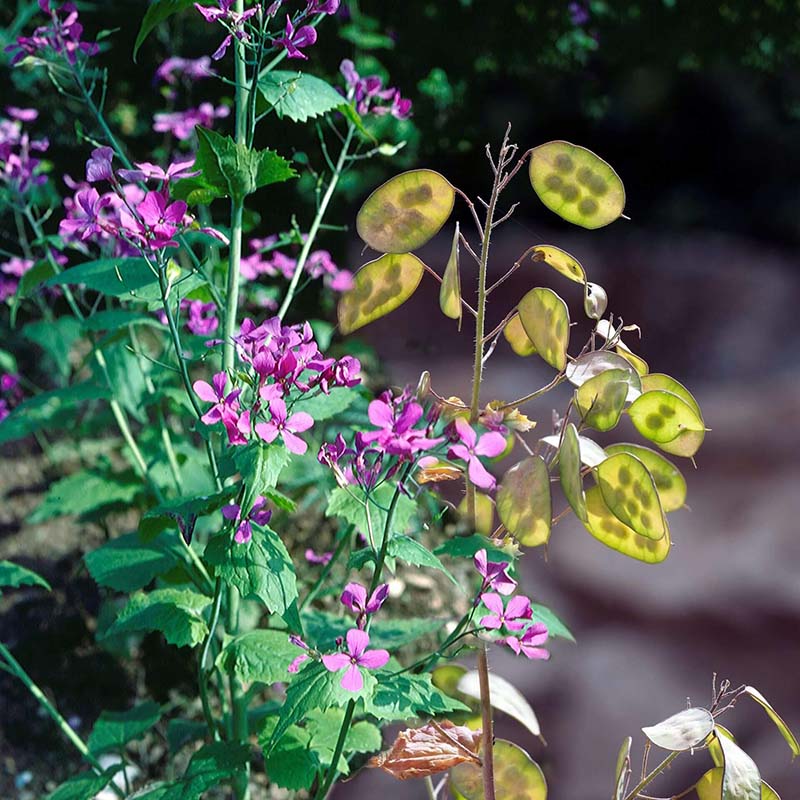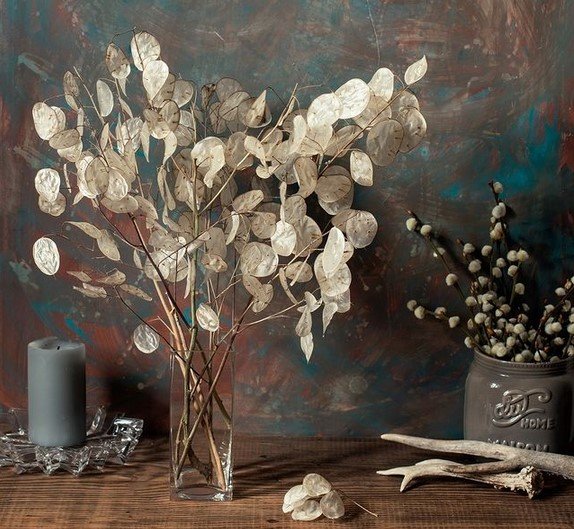Lunaria specifications
- Scientific name : Lunaria annua
- Order : Brassicales
- Family : Brassicaceae
- Genus : Lunaria
- Species : L. annua
- English names : honesty, annual honesty, silver dollar plant, money plant, moonwort
- Native : Balkans and south west Asia
Lunaria annua , called honesty or annual honesty in English, is a species of flowering plant in the cabbage and mustard family Brassicaceae. It is native to the Balkans and south west Asia, and cultivated throughout the temperate world.
It is an annual or biennial growing to 90 cm (35 in) tall by 30 cm (12 in) broad, with large, coarse, pointed oval leaves with marked serrations. The leaves are hairy, the lower ones long-stalked, the upper ones stalkless.
read more : Everything about needle grass ( stipa ) : How to Plant & care for them
In spring and summer it bears terminal racemes of white or violet flowers, followed by showy, green through light brown, translucent, disc-shaped silicles (not true botanical seedpods). When a silicle is ripe and dry, a valve on each of its sides readily falls off, and its seeds fall off a central membrane which has a silvery sheen, 3–8 cm (1–3 in) in diameter; the membrane can persist on a plant throughout a winter depending on the weather. These silicles are much used in dry floral arrangements.

In spring, this plant blooms beautiful and eye-catching flowers that have a fragrant scent. At the end of the summer, these flowers turn into oval leaves that are silvery in color and are widely used in sequined dried flowers .
The flowers of this plant, because they grow from purple, pink and a combination of the two, are very impressive at sunset. After a long time, when the flowers are pods and the pods are dry, their green color is determined and its silver part appears, which looks like a coin.
The life of this plant is about two years and in the second year of its life, their branches grow larger. At the beginning of the New Year, the lunaria annua flower, which has many fans, is widely used. After a long time, when the flowers are pods and the pods are dry, their green color is determined and its silver part appears, which looks like a coin.
read more : Everything about ruscus plant : How to Plant & care for them
Lunaria species include :
- L. annua (syn. L. biennis), annual or biennial
- L. elongata
- L. rediviva, perennial
- L. telekiana. rare Balkan species
Lunaria provenance
The main provenance of this type of plant is the British Isles. The lunaria annua plant can grow 60 to 90 cm.
Iran dried lunaria pods
If you want to create a dreamy atmosphere, the use of dried lunaria pods is highly recommended. These dried pods, while beautiful, is completely recyclable in nature and will always look beautiful in your space without being destroyed. The reasonable price of dried lunaria pods has made the sale and purchase of dried lunaria pods a great profit for the exporters and wholesalers of dried lunaria pods .
The pods can be used in dried floral arrangements, wreaths, and more. In fact, you do not even have to be proficient at floral design to use them—simply insert a few dried bundles into a vase for a unique display, or hang them from a hook over a window so that the sun can shine through them.
read more : Drying natural flowers | Introducing 8 wonderful ways to dry flowers

Lunaria Care
-
Light
Lunaria plants do well in both full sun and partial shade locations. In a hotter summer climate, a bit of afternoon shade is appreciated, but ultimately the plant should get around eight hours of sunlight daily in order to grow strong roots and eventually flower.
-
Soil
Grow your lunaria plants in a friable, deeply cultivated soil to accommodate their long taproots. Additionally, they prefer a soil mixture that is well-drained and humusy—it should stay evenly moist without becoming waterlogged. soil that stays (or, through irrigation, can be kept) evenly moist.
-
Water
Keep the soil your lunaria is housed in consistently moist throughout the growing season—about one inch of water (through rainfall or manual watering) a week should do. Keep in mind, the exact amount of water your plant needs can depend on your environment and its location in your landscape. Plants located in constant sunlight may be more thirsty than their shade-dwelling counterparts.
read more : Everything about palm plant : How to Plant & care for them
-
Temperature and Humidity
Lunaria plants need temperatures between 60 degrees and 70 degrees Fahrenheit to germinate and become established in the landscape. After that, as long as they’re planted in the proper USDA hardiness zone, they have no special temperature or humidity requirements.
-
Fertilizer
Once a year in the spring, treat your lunaria plant to a feeding with an organic or slow-release fertilizer to help encourage ample blooming.
-
Pruning Lunaria
A potential drawback in growing silver dollar plants is the ease with which they spread. Check with your county extension office before planting any to determine whether they are listed as invasive plants in your region (in which case they have the capability to crowd out native vegetation). As invasive plants go, though, lunaria plants are hardly among the worst offenders.
Under the right growing conditions, one plant will eventually multiply into many plants, and it’s their ability to re-seed that makes them such aggressive spreaders. However, if you’re hoping to contain your lunaria collection, controlling the plant is straightforward enough. Harvest the plants after their seed pods are fully developed but before they can drop any seed. This practice kills two birds with one stone since you will want to harvest them anyway in order to use the attractive seed pods.
read more : Everything about pyracantha plant : How to Plant & care for them
When you’re ready to harvest, cut off the plant at its base and bring it indoors. Tie your bundle of lunaria with some twine or string and suspend it upside-down in a room that boasts low humidity levels. The seed pods should be fully dried in about two to three weeks—you’ll notice that the husk (which is the green, outer layer) has likely fallen off by itself, but if it doesn’t, you can gently rub it off. Caring for the pods consists essentially of harvesting and drying them properly—they require virtually no maintenance beyond that.
Planting lunaria annua flower
With the arrival of spring or the end of summer, it is possible to plant the seeds of the lunaria annua plant. The seeds of this beautiful plant can be buried directly in the ground.
Notice : This article translated by google form Persian language. If you have any question or need more information please contact us or add a comment at the bottom of this page.

0 Comments